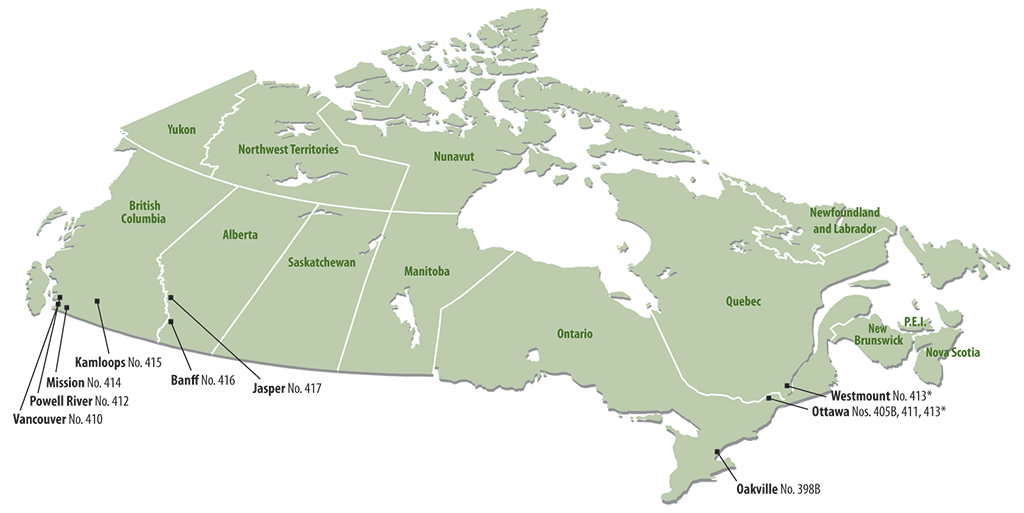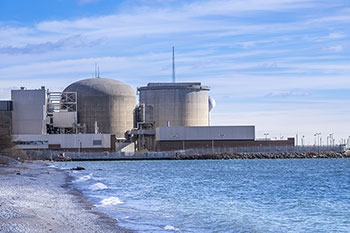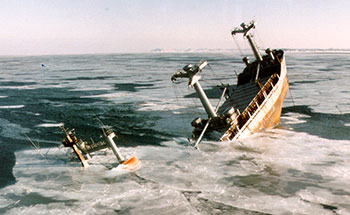
2018 Fall Reports of the Commissioner of the Environment and Sustainable Development to the Parliament of Canada Report 4—Environmental Petitions Annual Report
2018 Fall Reports of the Commissioner of the Environment and Sustainable Development to the Parliament of Canada Report 4—Environmental Petitions Annual Report
Table of Contents
Introduction
Environmental petitions process
4.1 The environmental petitions process is a unique way for Canadian residents to bring their concerns and questions about environmental issues to the attention of the federal ministers responsible and to obtain responses from them. It offers Canadians an opportunity to open a dialogue with their government. The Commissioner of the Environment and Sustainable Development administers the environmental petitions process on behalf of the Auditor General of Canada.
4.2 With the consent of petitioners, the Commissioner posts summaries of the environmental petitions on the Office of the Auditor General of Canada’s website in the Petitions Catalogue. Complete petitions are available on request in the language in which they were submitted. The catalogue includes summaries of all petitions received since 1996 and the ministerial responses to the petitions. The entire catalogue can be searched by federal institution, by issue, or by petition number.
4.3 More details about the environmental petitions process are provided in Appendix A. The Office’s website also provides more information about the process, and about the roles and responsibilities of the Commissioner and of federal government departments and agencies (see Getting Answers—A Guide to the Environmental Petitions Process).
Focus of the report
4.4 The purpose of this annual report is to inform Parliament and Canadians about the number, nature, and status of petitions and responses received between 1 July 2017 and 30 June 2018, as required by section 23 of the Auditor General Act.
4.5 In this report, we have also chosen to highlight the activities surrounding four past environmental petitions. We provide case studies to illustrate instances in which the government has addressed the issues raised by petitioners in these petitions and taken action. For example, petition 410 (Canada’s progress on implementing and reporting on Agenda 2030) represents an instance where an environmental petition has been employed as one of several means to highlight an issue of current concern. This issue was also addressed in a recent audit by the Commissioner of the Environment and Sustainable Development. In addition, petitions addressed in these case studies can have a long history, and issues addressed within them may take many years to resolve.
4.6 The following case studies are presented in Appendix B:
- Nuclear operator liabilities (Petition 60A)
- Expansion of boundaries for the proposed Lancaster Sound National Marine Conservation Area (Petition 348)
- Manolis L oil spill cleanup (Petition 373)
- Canada’s progress on implementing and reporting on Agenda 2030 (Petition 410)
Results for 2017–2018
Petitions received
4.7 The Office of the Auditor General of Canada received 10 environmental petitions between 1 July 2017 and 30 June 2018. The petitions originated from four provinces: British Columbia, Alberta, Ontario, and Quebec (Exhibit 4.1). Petition 413 was jointly submitted by petitioners from Ontario and Quebec.
Exhibit 4.1—Petitions came from four provinces between 1 July 2017 and 30 June 2018

British Columbia
410—Canada’s progress on implementing and reporting on Agenda 2030
414—Concerns about impacts of open-net fish farming on wild Pacific salmon
Alberta
416—Sustainable development in national parks
417—Clarification requested on the proposed Icefields Trail in Jasper National Park
Source: Petitions submitted to the Auditor General of Canada. Summaries are available on the Office of the Auditor General of Canada’s website.
Exhibit 4.1 map—text version
This map of Canada shows the communities from which the petitions came during the period from 1 July 2017 to 30 June 2018. Petitions came from four provinces: British Columbia, Alberta, Ontario, and Quebec.
British Columbia
- Vancouver: Petition 410
- Kamloops: Petition 415
- Powell River: Petition 412
- Mission: Petition 414
Alberta
- Jasper: Petition 417
- Banff: Petition 416
Ontario
- Ottawa: Petitions 405B, 411, 413
- Oakville: Petition 398B
Quebec
- Westmount: Petition 413
Note: Petition 413 was jointly submitted by petitioners from Ontario and Quebec.
4.8 Eighteen federal departments and agencies received petitions this year. Environment and Climate Change Canada received the most petitions (8), followed by Fisheries and Oceans Canada and Natural Resources Canada, which each received 4 petitions.
4.9 Key issues raised. Petitions addressed a wide variety of issues, including ecological integrity, the United Nations’ 2030 Agenda for Sustainable Development and the sustainable development goals, nuclear waste disposal and management, and environmental assessments of projects. Three petitions (405, 411, and 413) and one follow-up petition (405B) concerned cleaning up and preventing radioactive pollution from the nuclear industry in Canada and the environmental assessment regime for nuclear projects and facilities.
4.10 Petitioner satisfaction. This year, we conducted surveys to find out about petitioners’ experiences with the petitions process. There were some common themes. For example, petitioners told us they found that departmental and agency responses were vague or did not address the questions that had been asked. In fact, 9 out of 10 of the survey respondents rated the responses as unsatisfactory. However, the petitioners gave positive ratings to the responses that included specific examples and detailed information to support the responses’ conclusions. All the petitioners were satisfied with the level of support they received from the Commissioner of the Environment and Sustainable Development’s Petitions team. A majority of respondents said that, despite the nature of the responses received, they were likely to submit another petition.
Departmental and agency performance and responses
4.11 This reporting year, departments and agencies provided responses to 19 petitions, 13 of which had been submitted in the previous reporting period. All the petition responses were provided within the 120-day statutory deadline except for one department’s petition response, which was 6 days late.
4.12 While the vast majority of departments and agencies that were asked to respond to petition questions did so, in several instances, some declined to provide answers and gave no explanation beyond a short statement that the subject matter was outside their purview.
4.13 Environment and Climate Change Canada’s response to petition 412 (Jefferd Creek rerouting). The Minister told the petitioner that the issues raised fell outside the Department’s mandate but did not explain why. In contrast, the Minister provided a more detailed response to petition 405B, saying that the issues raised fell outside the Department’s mandate but did fall within the mandate of the Canadian Environmental Assessment Agency—a federal entity not required to respond to the petitions process. In our opinion, the Minister’s response to petition 405B was a more comprehensive response.
4.14 The Department of Finance Canada’s and Agriculture and Agri-Food Canada’s responses to petition 410 (Canada’s progress on implementing and reporting on Agenda 2030). The ministers of Finance and of Agriculture and Agri-Food Canada both told the petitioner that the questions raised in petition 410 fell outside the purview of their respective departments. Our team and the petitioner found this concerning given that there are several sustainable development goals, targets, and indicators that are directly related to their mandates. For example, the Department of Finance Canada, in its work on inefficient fuel subsidies, has a role to play in Canada’s progress toward meeting Goal 12 of the 2030 Agenda (Ensure sustainable consumption and production patterns). Agriculture and Agri-Food Canada, in its work in developing a food policy that promotes healthy, high-quality food for Canadians and its work in sustainable agriculture, has a role to play in Canada’s progress toward meeting Goal 2 (End hunger, achieve food security and improved nutrition and promote sustainable agriculture). Although both departments have noted their support for the implementation of the 2030 Agenda and the whole-of-government approach, there were no additional details provided in the departmental responses to the petitioner.
Improving the environmental petitions process
4.15 The fall 2017 Environmental Petitions Annual Report and Retrospective identified four key areas of the petitions process that we could enhance:
- Review and improve how we communicate the petitions process to Canadians.
- Review and improve how we help Canadians submit petitions.
- Review and improve how we help federal departments and agencies respond to petitions (including providing feedback on how satisfied petitioners are with responses).
- Examine other ways to incorporate petitions into our audit work.
This year we took action in these four areas, as follows.
4.16 Communicating the petitions process to Canadians. We have developed materials (article, contact card, and poster) to communicate the petitions process to Canadians. We have also reached out to various organizations to share information about the petitions process, answer questions, and provide advice on submitting a petition. For example, staff of the Office of the Auditor General of Canada delivered presentations on the petitions process via a webinar and in person at a national conference for post-secondary environmental educators and sustainability professionals. We have also initiated our outreach to key Indigenous organizations in Canada.
4.17 Improving how we help Canadians. In the past year, we offered a survey to petitioners. All petitioners can now complete a survey on the departmental and agency responses they have received to their petitions. The survey gives petitioners the option of permitting their comments to be shared with officials from those departments and agencies.
4.18 Improving how we help federal organizations. To improve the guidance we offer to federal departments and agencies, the Petitions team met with an interdepartmental community of practice for federal officials managing the petitions process to
- clarify the process,
- highlight some best practices,
- answer questions, and
- receive feedback.
4.19 We have developed additional guidance for federal officials who respond to petitions and shared it with them. We have also provided feedback to departments and agencies on the survey responses provided about the level of petitioner satisfaction.
4.20 Finding ways to incorporate petitions into our audit work. We shared petitions and their responses with other audit staff of the Office of the Auditor General of Canada in our performance audit work. For example, petition 410, about Canada’s progress in meeting the country’s commitments for the United Nations’ 2030 Agenda for Sustainable Development, was referenced in the Commissioner of the Environment and Sustainable Development’s spring 2018 report entitled Canada’s Preparedness to Implement the United Nations’ Sustainable Development Goals.
Period covered by the report
With regard to the environmental petitions process, the report covers the period between 1 July 2017 and 30 June 2018. However, for the four case studies, the report covers the period between the date each of the petitions was submitted and 31 July 2018.
Petitions team
Principal: Kimberley Leach
Director: George Stuetz
Vanessa Alboiu
Nicole Lee
Roxanne Lepage
Kris Nanda
Mary-Lynne Weightman
Appendix A—About the petitions process
The environmental petitions process and the role of the Commissioner of the Environment and Sustainable Development
Environmental petitions process
Starting a petition
A Canadian resident submits a written petition to the Auditor General of Canada.
Reviewing a petition
The Commissioner reviews the petition to determine whether it meets the requirements of the Auditor General Act.
If the petition meets the requirements of the Auditor General Act, the Commissioner will
- determine which federal departments and agencies may be responsible for the issues addressed in the petition;
- send it to the ministers responsible; and
- send a letter to the petitioner, listing the ministers to whom the petition was sent.
If the petition does not meet the requirements of the Auditor General Act, the petitioner will be informed in writing.
If the petition is incomplete or unclear, the petitioner will be asked to resubmit it.
Responding to a petition
Once a minister receives a petition, he or she must
- send a letter, within 15 days, to the petitioner and the Commissioner acknowledging receipt of the petition; and
- consider the petition and send a reply to the petitioner and the Commissioner within 120 days.
Ongoing petition activities
Monitoring
The Commissioner monitors acknowledgement letters and responses from ministers.
Reporting
The Commissioner reports to Parliament on the petitions and responses received.
Posting on the Internet
The Commissioner posts summary information of each petition, and the responses, on the Internet in both official languages.
Auditing
The Office of the Auditor General considers issues raised in petitions when planning future audits.
Outreach
The Commissioner carries out a variety of outreach activities to inform Canadians about the petitions process.
Source: Adapted from the Auditor General Act and Getting Answers—A Guide to the Environmental Petitions Process.
Appendix B—Case studies
Case study: Nuclear operator liabilities

Pickering Nuclear Generating Station, Pickering, Ontario
Photo: Ken Felepchuk/Shutterstock.com
Petition 60A
Petition 60A, submitted in November 2002, raised concerns that the level of required insurance coverage under the Nuclear Liability Act was not enough to adequately address the environmental and human health risks of nuclear facilities.
Background
The Nuclear Liability Act came into effect in 1976 and required that funds be available to compensate those who suffered injury or damage arising from radioactive releases. Although the Act held nuclear operators liable, it limited an operator’s liability to a maximum of $75 million, leaving the federal government responsible for the balance above this amount.
Departmental response
In response to Petition 60A, the Minister of Natural Resources acknowledged the need to revise the Act and “bring it up to international standards.”
Office of the Auditor General of Canada audits
The Commissioner of the Environment and Sustainable Development’s 2005 audit on insurance for nuclear operators concluded that the liability amount remained at $75 million, considerably lower than the coverage in 12 other major industrialized nations. A follow-up audit in 2008 found that Natural Resources Canada had drafted legislation, introduced in Parliament in October 2007 as Bill C-5, which updated the mandatory insurance requirements for nuclear operators, as recommended in the 2005 audit.
Recent actions on issues raised
The Nuclear Liability and Compensation Act (NLCA) replaced the Nuclear Liability Act and the $75 million liability cap. The NLCA, which came into effect on 1 January 2017, raised liability for nuclear power plant operators to $650 million in 2017. That amount will ultimately increase to $1 billion in 2020 over a three-year transition period. The NLCA allowed Canada to become a part of the International Atomic Energy Agency’s Convention on Supplementary Compensation for Nuclear Damage in 2017. Canada is thus eligible to receive up to 108 million SDRs (special drawing rights) (about CAN$200 million as of 19 July 2018) in supplemental funding in case of a nuclear incident.
Case study: Expansion of boundaries for the proposed Lancaster Sound National Marine Conservation Area

Beluga whale, Cunningham Inlet, Nunavut
Photo: Jennifer G. Lang/Shutterstock.com
Petition 348
Petition 348, submitted by the Arctic Watch Beluga Foundation in January 2013, raised concerns that the proposed Lancaster Sound National Marine Conservation Area (NMCA), now known as the Tallurutiup Imanga NMCA, did not include the entire migration route for beluga whales to their summer breeding area in Cunningham Inlet. The petitioner was also concerned about the potential impact that an increased level of human activity, including tourism, might have on beluga whales if Cunningham Inlet was not protected.
Background
Lancaster Sound is a significant ecological area located in the northeastern region of Nunavut that provides critical habitat for species such as the polar bear, bowhead whale, narwhal, and beluga whale. For Inuit living in the region, Lancaster Sound is a place of both cultural and ecological importance. In December 2009, a memorandum of understanding was signed between the federal and Nunavut environment ministers and the president of the Qikiqtani Inuit Association. It created a steering committee, which launched a feasibility assessment in 2011 to determine whether Lancaster Sound would be a suitable location for an NMCA.
Agency response
Parks Canada’s response stated that the final boundary for the proposed Lancaster Sound NMCA would not be decided until the feasibility assessment for the proposed NMCA was completed. The response also stated that “recommendations such as those expressed in this environmental petition will be considered when the boundaries are finalized.”
Recent actions on issues raised
The steering committee completed consultations and ecological and traditional-knowledge studies for the proposed Lancaster Sound NMCA in 2016. The final feasibility assessment report was submitted in February 2017 and included Cunningham Inlet within the recommended NMCA boundaries. On 14 August 2017, the Government of Canada, the Government of Nunavut, and the Qikiqtani Inuit Association announced an agreement on the final boundary for the Tallurutiup Imanga NMCA (formerly proposed as the Lancaster Sound NMCA), which includes Cunningham Inlet.
As of 31 July 2018, the NMCA has not yet been formally established. Parks Canada has indicated that it is targeting a March 2019 date for completing an Inuit Impact and Benefit Agreement, after which time the Government of Canada will enact legislation to establish the NMCA.
Case study: Manolis L oil spill cleanup

Manolis L shipwreck, Notre Dame Bay, Newfoundland and Labrador
Photo: Maritime History Archive, Memorial University of Newfoundland
Petition 373
Petition 373, submitted in February 2015 by the Manolis L Citizens Response Committee, raised concerns about federal measures to mitigate damage and clean up oil leaking from the 1985 shipwreck of the Manolis L and about the lack of access to the Ship-source Oil Pollution Fund.
Background
When reports began to emerge of oil slicks and oiled birds in Notre Dame Bay, Newfoundland and Labrador, in April 2013, the source was determined to be the wreckage of the Manolis L, a general cargo vessel that ran aground on 17 January 1985. The Canadian Coast Guard made various efforts to stop the leak from May 2013 through May 2016. Approximately 3,860 litres of oil were removed from the Manolis L as a result of these efforts, although leaks continued. As of May 2016, the estimated total quantity of fuel and diesel contained in the Manolis L was estimated to be between 115,000 and 150,000 litres.
Departmental response
Fisheries and Oceans Canada, with input from Transport Canada and Environment Canada, issued a joint response to the petition on 25 June 2015. Fisheries and Oceans Canada expressed that actions taken to date were effective in protecting the marine environment and that the Manolis L did not pose an imminent threat of pollution. The response noted that since 2013, the Canadian Coast Guard and Transport Canada had incurred $1.7 million and $193,997 respectively in cleanup costs. The Minister of Fisheries and Oceans also stated that the Canadian Coast Guard was exploring ongoing plans for the long-term management of the site.
Recent actions on issues raised
Since the 2015 response to petition 373, the Government of Canada has made further commitments to explore options for the long-term management of shipwrecks. For example, on 30 October 2017, the Minister of Transport introduced Bill C-64, the Wrecked, Abandoned or Hazardous Vessels Act, which enhances vessel owner responsibility and liability for the cleanup of vessels and wrecks posing hazards. This would apply to new shipwrecks that occur after the legislation comes into force.
With respect to the Manolis L itself, the Canadian Coast Guard announced in April 2018 that it had awarded a $15,106,400 contract for the removal of all recoverable oil to significantly mitigate the threat of future oil leaks emanating from the Manolis L wreck. According to Fisheries and Oceans Canada, the work to remove the bulk oil from the Manolis L began in summer 2018.
Case study: Canada’s progress on implementing and reporting on Agenda 2030

Sustainable development goals, United Nations’ 2030 Agenda for Sustainable Development
Source: United Nations
Petition 410
Petition 410 was submitted by the British Columbia Council for International Cooperation in September 2017. The petition sought responses from 17 federal departments and agencies on Canada’s progress in meeting the sustainable development goals (SDGs) and associated targets outlined in the United Nations’ 2030 Agenda for Sustainable Development.
Background
Transforming Our World: The 2030 Agenda for Sustainable Development was adopted in September 2015 by the 193 Member States of the General Assembly of the United Nations, including Canada, and came into effect on 1 January 2016. The agreement included 17 SDGs with 169 associated targets, which cover the economic, environmental, and social dimensions of sustainable development over the next 15 years.
Departmental and agency responses
All 17 federal departments and agencies provided responses to the petition. The responses emphasized that implementing the SDGs would require a whole-of-government approach and a cross-section of partners and stakeholders. Four departments provided specific information about how their organizations’ actions would contribute to achieving the SDGs. However, we found two of the responses unsatisfactory. Agriculture and Agri-Food Canada and the Department of Finance Canada both stated that the questions fell outside their departmental purview. Our team and the petitioner found this concerning given that there are several SDGs, targets, and indicators that are directly related to their mandates.
Office of the Auditor General of Canada audits
The Commissioner of the Environment and Sustainable Development’s spring 2018 report entitled Canada’s Preparedness to Implement the United Nations’ 2030 Agenda for Sustainable Development focused on whether the Government of Canada, as represented by the selected seven federal organizations, was prepared to implement the 2030 Agenda. We concluded that the Government of Canada was not adequately prepared to implement the 2030 Agenda. The Government of Canada clearly committed to implementing the 2030 Agenda and took some action at the departmental level. However, at the end of our audit, we found that there was no governance structure and limited national consultation and engagement on the 2030 Agenda. There was no implementation plan with a system to measure, monitor, and report on progress nationally. Statistics Canada had developed a data framework to measure results on the 232 global indicators. However, results were not available because the data had not yet been compiled.
Recent actions on issues raised
In the 2018 federal budget, the Government of Canada announced that it would provide $49.4 million over 13 years to establish an SDG unit and to fund monitoring and reporting activities by Statistics Canada. This funding is intended to enable better coordination among all levels of government, civil society organizations, and the private sector on Canada’s efforts on the 2030 Agenda and to support the monitoring and reporting of Canada’s domestic and international efforts to ensure that all of the SDGs are achieved by 2030. The budget also proposed to provide, from existing departmental resources, up to $59.8 million over 13 years, starting in the 2018–19 fiscal year, for programming to support the implementation of the SDGs.
On 17 April 2018, the Government of Canada announced it was taking steps to develop a national strategy and launched a Voluntary National Review web portal to invite Canadians to share how they are helping advance the SDGs at home and abroad.
On 17 July 2018, Canada presented its first Voluntary National Review report at the United Nations’ High-level Political Forum on Sustainable Development in New York. This report takes stock of national actions, achievements, and challenges, and identifies the next step in implementing the 2030 Agenda. According to the report, the Minister of Children, Families and Social Development will lead Canada’s implementation of the 2030 Agenda, and all federal ministers, departments, and agencies will be accountable for implementing the 2030 Agenda and supporting the national strategy. This will include the responsibility to develop a national strategy through stakeholder engagement, raise public awareness, and foster new partnerships and networks.
